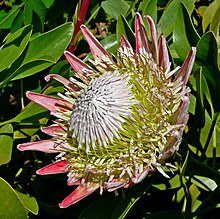
Back Proteaceae Afrikaans بروطية Arabic بروطيه ARZ Proteaceae AST Proteyakimilər Azerbaijani Пратэйныя Byelorussian Протейнови Bulgarian Proteaceae BS Proteàcies Catalan Proteaceae CEB
| Proteaceae Temporal range: [1]
| |
|---|---|

| |
| Inflorescence of Protea cynaroides | |
| Scientific classification | |
| Kingdom: | Plantae |
| Clade: | Tracheophytes |
| Clade: | Angiosperms |
| Clade: | Eudicots |
| Order: | Proteales |
| Family: | Proteaceae Juss.[2] |
| Genera | |
|
About 80, see text | |
The Proteaceae /ˌproʊtiˈeɪsiː/ form a family of flowering plants predominantly distributed in the Southern Hemisphere. The family comprises 83 genera with about 1,660 known species.[3] Australia and South Africa have the greatest concentrations of diversity. Together with the Platanaceae (plane trees), Nelumbonaceae (the sacred lotus) and in the recent APG IV system the Sabiaceae, they make up the order Proteales. Well-known Proteaceae genera include Protea, Banksia, Embothrium, Grevillea, Hakea, and Macadamia. Species such as the New South Wales waratah (Telopea speciosissima), king protea (Protea cynaroides), and various species of Banksia, Grevillea, and Leucadendron are popular cut flowers. The nuts of Macadamia integrifolia are widely grown commercially and consumed, as are those of Gevuina avellana on a smaller scale.
- ^ "Proteales". www.mobot.org. Retrieved 16 June 2023.
- ^ Angiosperm Phylogeny Group logo m moi lo (2009). "An update of the Angiosperm Phylogeny Group classification for the orders and families of flowering plants: APG III". Botanical Journal of the Linnean Society. 161 (2): 105–121. doi:10.1111/j.1095-8339.2009.00996.x. hdl:10654/18083.
- ^ Christenhusz, M. J. M. & Byng, J. W. (2016). "The number of known plants species in the world and its annual increase". Phytotaxa. 261 (3): 201–217. doi:10.11646/phytotaxa.261.3.1.
© MMXXIII Rich X Search. We shall prevail. All rights reserved. Rich X Search